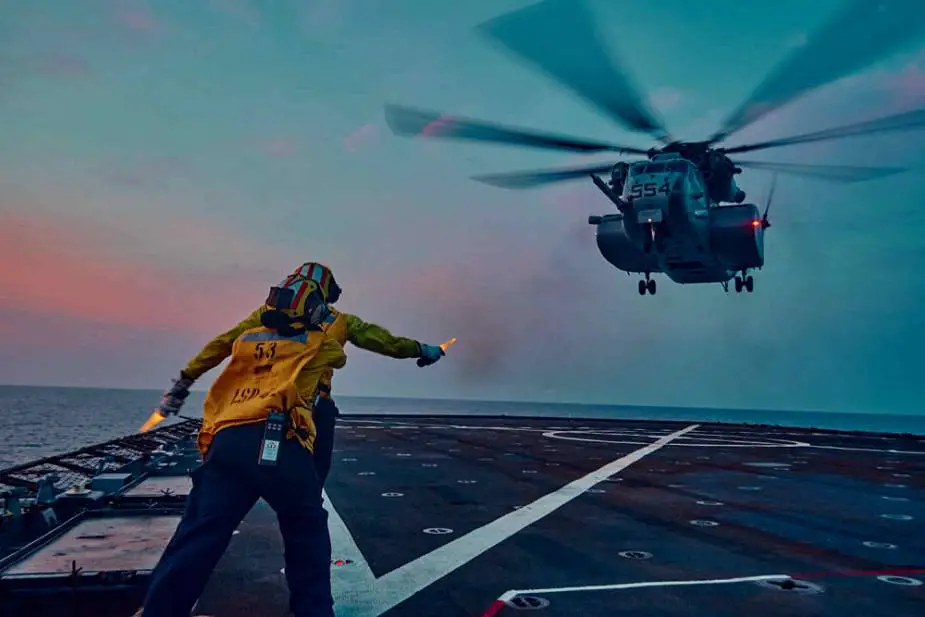According to pictures published by the United States Department of Defense (DoD), U.S. Navy Helicopter Mine Countermeasures Squadron 14 (HM-14) Detachment 2A has conducted Deck Landing Qualifications (DLQs) with MH-53 Sea Dragon on USS Germantown (LSD 42) amphibious dock landing ship.
Follow Navy Recognition on Google News at this link
 U.S. sailors from amphibious dock landing ship USS Germantown (LSD 42) signal a MH-53 Sea Dragon, attached to Helicopter Mine Countermeasures Squadron 14 (HM-14) Detachment 2A, while conducting Deck Landing Qualifications (DLQs) at sunset. (Picture source U.S. Navy)
U.S. sailors from amphibious dock landing ship USS Germantown (LSD 42) signal a MH-53 Sea Dragon, attached to Helicopter Mine Countermeasures Squadron 14 (HM-14) Detachment 2A, while conducting Deck Landing Qualifications (DLQs) at sunset. (Picture source U.S. Navy)
The Helicopter Mine Countermeasures Squadron 14 (HM-14) is a United States Navy helicopter squadron established in 1978 based at Naval Station Norfolk, Virginia. HM-14's mission is to stand ready to deploy anywhere in the world within 72 hours via US Air Force C-5 Galaxy to provide airborne mine countermeasures and vertical onboard delivery support.
The squadron has 17 MH-53E Sea Dragon aircraft and 700 total members including pilots, aircrew, maintainers, and administrative personnel. The squadron has all of the typical departments of an aviation squadron, as well as a dedicated AMCM department, responsible for maintaining the minehunting and minesweeping gear and the RHIBs used for tending them.
The MH-53E Sea Dragon is a naval version of the CH-53E Super Stallion heavy-lift helicopter used to conduct two type of missions including Airborne Mine Counter Measure (AMCM) mission and Navy Vertical Onboard Delivery (VOD) mission.
The MH-53E Sea Dragon incorporates Global Positioning System (GPS), Doppler radar, and an Approach/Hover/Tow Coupler. Communications include Ultra High Frequency (UHF)/ Very High Frequency (VHF)/ High Frequency (HF) radios, secure communications capability, and Identified Friend or Foe (IFF). The MH-53E Sea Dragon will perform the Airborne Mine Countermeasures (AMCM) mission until at least 2025. Currently out of production. The Navy is in the process of evaluating its requirement for both AMCM and VOD missions beyond 2025.
The USS Germantown (LSD-42) is the second Whidbey Island-class dock landing ship in service with the United States Navy. The ship was launched in June 1984 and commissioned in February 1986.
The Whidbey Island-class dock landing ship is a dock landing ship of the United States Navy. Introduced to fleet service in 1985, this class of ship features a large well deck for the transport of United States Marine Corps (USMC) vehicles and a large flight deck for the landing of helicopters or V-22 Ospreys. The well deck was designed to hold four LCAC hovercraft, five if the vehicle ramp is raised, for landing Marines. Recent deployments have instead filled the well deck with a combination of LCU(s), AAVs, Tanks, LARCs and other USMC vehicles and gear.



